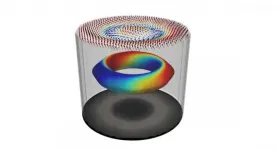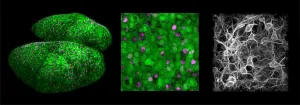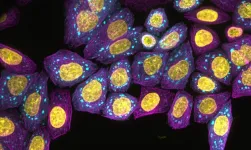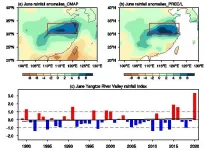(Press-News.org) A decade ago, the discovery of quasiparticles called magnetic skyrmions provided important new clues into how microscopic spin textures will enable spintronics, a new class of electronics that use the orientation of an electron's spin rather than its charge to encode data.
But although scientists have made big advances in this very young field, they still don't fully understand how to design spintronics materials that would allow for ultrasmall, ultrafast, low-power devices. Skyrmions may seem promising, but scientists have long treated skyrmions as merely 2D objects. Recent studies, however, have suggested that 2D skyrmions could actually be the genesis of a 3D spin pattern called hopfions. But no one had been able to experimentally prove that magnetic hopfions exist on the nanoscale.
Now, a team of researchers co-led by Berkeley Lab has reported in Nature Communications the first demonstration and observation of 3D hopfions emerging from skyrmions at the nanoscale (billionths of a meter) in a magnetic system. The researchers say that their discovery heralds a major step forward in realizing high-density, high-speed, low-power, yet ultrastable magnetic memory devices that exploit the intrinsic power of electron spin.
"We not only proved that complex spin textures like 3D hopfions exist - We also demonstrated how to study and therefore harness them," said co-senior author Peter Fischer, a senior scientist in Berkeley Lab's Materials Sciences Division who is also an adjunct professor in physics at UC Santa Cruz. "To understand how hopfions really work, we have to know how to make them and study them. This work was possible only because we have these amazing tools at Berkeley Lab and our collaborative partnerships with scientists around the world," he said.
According to previous studies, hopfions, unlike skyrmions, don't drift when they move along a device and are therefore excellent candidates for data technologies. Furthermore, theory collaborators in the United Kingdom had predicted that hopfions could emerge from a multilayered 2D magnetic system.
The current study is the first to put those theories to test, Fischer said.
Using nanofabrication tools at Berkeley Lab's Molecular Foundry, Noah Kent, a Ph.D. student in physics at UC Santa Cruz and in Fischer's group at Berkeley Lab, worked with Molecular Foundry staff to carve out magnetic nanopillars from layers of iridium, cobalt, and platinum.
The multilayered materials were prepared by UC Berkeley postdoctoral scholar Neal Reynolds under the supervision of co-senior author Frances Hellman, who holds titles of senior faculty scientist in Berkeley Lab's Materials Sciences Division, and professor of physics and materials science and engineering at UC Berkeley. She also leads the Department of Energy's Non-Equilibrium Magnetic Materials (NEMM) program, which supported this study.
Hopfions and skyrmions are known to co-exist in magnetic materials, but they have a characteristic spin pattern in three dimensions. So, to tell them apart, the researchers used a combination of two advanced magnetic X-ray microscopy techniques - X-PEEM (X-ray photoemission electron microscopy) at Berkeley Lab's synchrotron user facility, the Advanced Light Source; and magnetic soft X-ray transmission microscopy (MTXM) at ALBA, a synchrotron light facility in Barcelona, Spain - to image the distinct spin patterns of hopfions and skyrmions.
To confirm their observations, the researchers then carried out detailed simulations to mimic how 2D skyrmions inside a magnetic device evolve into 3D hopfions in carefully designed multilayer structures, and how these will appear when imaged by polarized X-ray light.
"Simulations are a hugely important part of this process, enabling us to understand the experimental images and to design structures that will support hopfions, skyrmions, or other designed 3D spin structures," Hellman said.
To understand how hopfions will ultimately function in a device, the researchers plan to employ Berkeley Lab's unique capabilities and world-class research facilities - which Fischer describes as "essential for carrying out such interdisciplinary work" - to further study the quixotic quasiparticles' dynamical behavior.
"We have known for a long time that spin textures are almost inevitably three dimensional, even in relatively thin films, but direct imaging has been experimentally challenging," said Hellman. "The evidence here is exciting, and it opens doors to finding and exploring even more exotic and potentially significant 3D spin structures."
INFORMATION:
Co-authors with Fischer and Hellman include David Raftrey, Ian T.G. Campbell, Selven Virasawmy, Scott Dhuey, and Rajesh V. Chopdekar of Berkeley Lab; Aurelio Hierro-Rodriguez of the University of Oviedo, and Andrea Sorrentino, Eva Pereiro, and Salvador Ferrer of the ALBA Synchrotron, Spain.
The Advanced Light Source and Molecular Foundry are DOE Office of Science user facilities at Berkeley Lab.
This work was supported by the U.S. Department of Energy Office of Science.
Founded in 1931 on the belief that the biggest scientific challenges are best addressed by teams, Lawrence Berkeley National Laboratory and its scientists have been recognized with 14 Nobel Prizes. Today, Berkeley Lab researchers develop sustainable energy and environmental solutions, create useful new materials, advance the frontiers of computing, and probe the mysteries of life, matter, and the universe. Scientists from around the world rely on the Lab's facilities for their own discovery science. Berkeley Lab is a multiprogram national laboratory, managed by the University of California for the U.S. Department of Energy's Office of Science.
DOE's Office of Science is the single largest supporter of basic research in the physical sciences in the United States, and is working to address some of the most pressing challenges of our time. For more information, please visit energy.gov/science.
In all adult vertebrates, neural stem cells can be recruited to produce new neurons in the brain. However, little is known about these so-called "activation" processes.
Scientists at the Institut Pasteur, CNRS, and Tel Aviv University working in collaboration with the École Polytechnique and INRAE have successfully performed 3D visualization and spatial and temporal distribution analysis of neural stem cell activation in the adult brain of a zebrafish vertebrate model.
Their findings demonstrate for the first time that activation events for these cells are coordinated ...
Powerful algorithms used by Netflix, Amazon and Facebook can 'predict' the biological language of cancer and neurodegenerative diseases like Alzheimer's, scientists have found.
Big data produced during decades of research was fed into a computer language model to see if artificial intelligence can make more advanced discoveries than humans.
Academics based at St John's College, University of Cambridge, found the machine-learning technology could decipher the 'biological language' of cancer, Alzheimer's, and other neurodegenerative diseases.
Their ground-breaking study has been published in the scientific journal PNAS today (April 8 2021) and could be used in the future to 'correct the grammatical mistakes inside cells that cause disease'.
Professor Tuomas Knowles, lead ...
The prevalence of SARS-CoV-2 infections in preschool and school children is an important benchmark for deciding whether to open kindergartens and schools. The screening study "Fr1da" led by Anette-Gabriele Ziegler tests children in Bavaria for an early stage of type 1 diabetes. These tests include the collection of blood samples. In response to the COVID-19 pandemic, the researchers had decided to use the valuable study infrastructure of the Fr1da study to detect SARS-CoV-2 infections, too. For this, they developed a SARS-CoV-2 antibody test with particularly high accuracy. During the first ...
The rainfall over the Yangtze River Valley (YRV) in June 2020 broke the record since 1979 (Figure 1). As of June 28, the People's Daily Online reported that there were more than 12 million people affected by flood disasters related to this torrential rain, with deaths or disappearances of 78 persons and a direct economic loss of more than 25 billion CNY. Recently, scientists from South China Sea Institute of Oceanology (SCSIO), Chinese Academy of Sciences revealed the cause of the record-breaking rainfall over the YRV.
According to their study published in Science China Earth Sciences on March 19, 2021, all three oceans of the Pacific, Indian and Atlantic Oceans ...
Researchers from Tokyo Medical and Dental University (TMDU) demonstrate an mRNA delivery system that effectively produces BDNF protein in rat brain to protect neurons from ischemia
Tokyo - A lack of oxygen to brain tissue--known as ischemia--leads to the death of neurons, which results in stroke. Despite considerable research, there are currently no treatments that successfully prevent neuronal death. Now, Tokyo Medical and Dental University (TMDU) researchers have reported a way of delivering mRNA to produce a therapeutic protein that protects neurons. Their findings, demonstrated in rats, ...
Cycling at moderate intensity during dialysis could drastically improve the heart health of patients with kidney failure and result in significant savings for the NHS, according to new research by the University of Leicester supported by the charity Kidney Research UK and National Institute for Health Research (NIHR) Leicester Biomedical Research Centre.
Patients in the CYCLE-HD study were offered 30 minutes of moderate intensity exercise on a specially adapted bicycle during their regular dialysis sessions. Dialysis can lead to long-term scarring of the heart, which can accumulate over time and lead to heart failure. The study set out to examine ...
Ensuring sustainability of crop and timber production would mitigate the greatest drivers of terrestrial wildlife decline, responsible for 40% of the overall extinction risk of amphibians, birds and mammals, according to a paper published today in Nature Ecology & Evolution. These results were generated using a new metric which, for the first time, allows business, governments and civil society to assess their potential contributions to stemming global species loss, and can be used to calculate national, regional, sector-based, or institution-specific targets. The work was led by the IUCN Species Survival Commission's Post-2020 Taskforce, hosted by Newcastle ...
New Curtin University-led research has found climate change will have a substantial impact on global food production and health if no action is taken by consumers, food industries, government, and international bodies.
Published in one of the highest-ranking public health journals, the Annual Review of Public Health, the researchers completed a comprehensive 12-month review of published literature on climate change, healthy diet and actions needed to improve nutrition and health around the world.
Lead researcher John Curtin Distinguished Emeritus Professor Colin Binns, from the Curtin School of Population Health at Curtin University, said climate change has had a detrimental impact on health and food production for the past 50 years and far more needs to be ...
A Curtin University study has found the introduced European honeybee could lead to native bee population decline or extinction when colonies compete for the same nectar and pollen sources in urban gardens and areas of bush.
Published in the 'Biological Journal of the Linnean Society', the research found competition between the native bees and the introduced European honeybee could be particularly intense in residential gardens dominated by non-native flowers, and occurred when the bees shared the same flower preferences.
Under these conditions, it would appear that European honeybees, being very abundant, and effective foragers, with the ...
How can large amounts of data be transferred or processed as quickly as possible? One key to this could be graphene. The ultra-thin material is only one atomic layer thick, and the electrons it contains have very special properties due to quantum effects. It could therefore be very well suited for use in high-performance electronic components. Up to this point, however, there has been a lack of knowledge about how to suitably control certain properties of graphene. A new study by a team of scientists from Bielefeld and Berlin, together with researchers from other research institutes in Germany and Spain, is changing this. The team's findings have been published in the journal Science Advances.
Consisting of carbon atoms, graphene is a material just one atom ...





